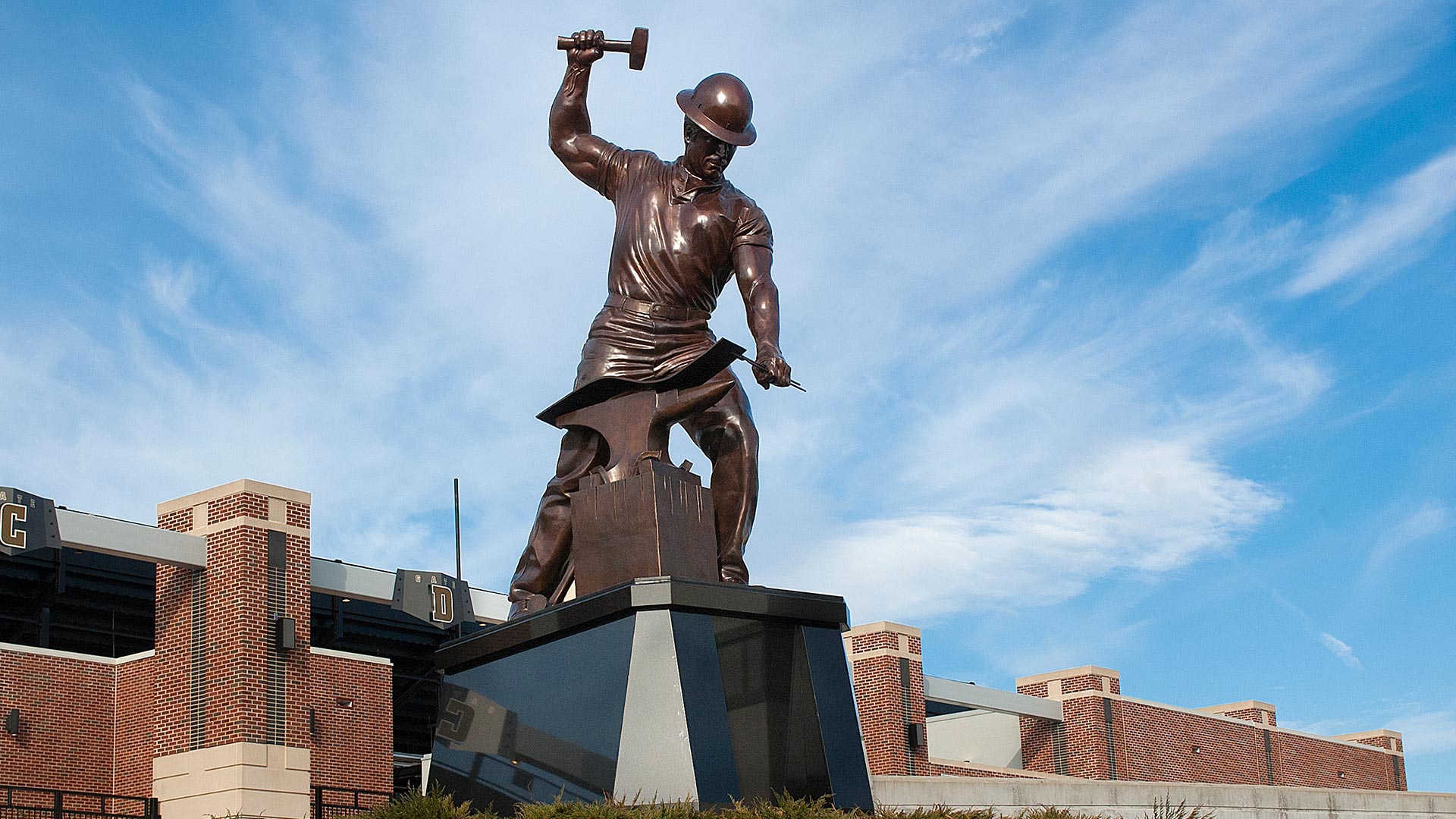Business and Industry
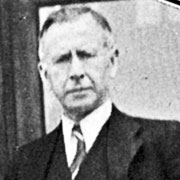
Charles Alton Ellis
Golden Gate Bridge Engineer
Charles Alton Ellis, a professor of civil engineering at Purdue from 1934-46, was among the engineers who collaborated on the construction of the Golden Gate Bridge. Ellis wasn’t recognized for his contribution to the bridge until the 1980s, despite helping design, in his own words, “every nut and bolt on the darn thing.”
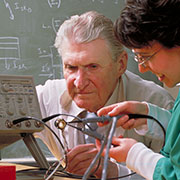
Leslie Geddes
Technological Innovator
Leslie Geddes was the Showalter Distinguished Professor Emeritus of Biomedical Engineering. In 2004, Geddes received Purdue’s Outstanding Commercialization Award to recognize his 30 patents, many now licensed by Indiana companies. Patents and technologies emerging from Geddes’ laboratory have generated more than $15 million in royalties for Purdue.
He received the 2006 National Medal of Technology from President George W. Bush in a White House ceremony in 2007. The award is the nation’s highest honor for technological innovation.
Among the accomplishments during his career spanning 50-plus years were innovations ranging from burn treatments to miniature defibrillators, from ligament repair to tiny blood pressure monitors for premature infants.
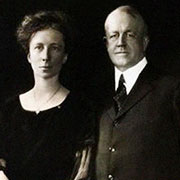
Frank and Lillian Gilbreth
Industrial Management Pioneers
Frank and Lillian Gilbreth were renowned as the “Father and Mother of Modern Management,” and their motion study work continues to interest and attract researchers. The Gilbreths’ research introduced using photography and motion pictures to study and help improve the efficiency of industrial workers and minimize worker fatigue.
In 1935, Lillian Gilbreth became the first female professor in the College of Engineering. She also accepted the role of consultant for careers for women and helped establish a time and motion study laboratory at Purdue. She retired from the university in 1948.
The couple also raised 12 children together, and the story of their family life has been recounted in numerous journal articles, books and films, notably “Cheaper by the Dozen.”
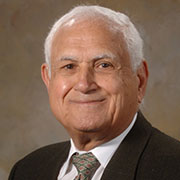
Adel Halasa
Rubber Technology Pioneer
Adel Halasa is credited with developing the tire tread polymers for the Goodyear Aquatred tire, released in 1991. He received his doctorate in chemistry from Purdue in 1964.
Halasa has more than 250 patents and is a 1997 recipient of the Charles Goodyear Medal given by the American Chemical Society, Rubber Division, to members who “have exhibited exceptional technical competence by making significant and repeated contributions to rubber technology.” In 1998, 2000 and 2005 he was named Goodyear Inventor of the Year. He also received the 2003 Distinguished Science Alumni Award from Purdue.
Halasa established the first facilities in Kuwait for the use of sulfur in asphalt road applications.
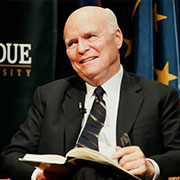
Brian Lamb
Communication Leader
In 1977, Brian Lamb, a Purdue alumnus, founded C-SPAN — Cable-Satellite Public Affairs Network. The network’s initial telecasts of the U.S. House of Representatives commenced in 1979, and today there are three C-SPAN networks offering around-the-clock coverage of the political process.
Lamb earned his bachelor’s degree in speech in 1963 and received an honorary doctorate from Purdue in 1986. In 2007, he received the Presidential Medal of Freedom and was named Washingtonian of the Year. In 2003, he was awarded the Freedom of Speech Award, the National Humanities Medal and the Harry S. Truman Good Neighbor Award.
In 1987, Lamb designated Purdue as the original home of the C-SPAN Archives, which records, indexes and archives all C-SPAN programming for historical, educational and research uses. Now located in the Purdue Research Park and operated and entirely funded by C-SPAN, the Archives records, stores and makes accessible every C-SPAN program aired since 1987, totaling more than 160,000 hours. In 2011, Purdue named the Brian Lamb School of Communication after the Lafayette, Indiana, native.
Before C-SPAN, Lamb was publisher of The Media Report, Washington bureau chief for CableVision magazine, freelance reporter for United Press International Audio and public affairs officer in the Navy for the Pentagon. Lamb also served as a military social aide for the White House under President Lyndon B. Johnson and as the media and congressional relations director for the Office of Telecommunications Policy during the Nixon administration.
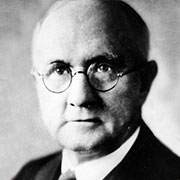
Elwood Mead
Hoover Dam Engineer
An 1884 graduate in one of Purdue’s first agriculture classes, Elwood Mead was an irrigation expert who provided his expertise in Indiana and Wyoming as well as overseas in Australia, Palestine and South Africa. In 1924, he was named commissioner of the Bureau of Reclamation of the U.S. Department of Interior. He went on to become the chief engineer behind the construction of the Hoover Dam. The dam’s reservoir — the largest man-made reservoir — bears his name, Lake Mead.
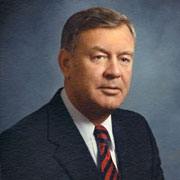
Charles Pankow
Construction Pioneer
Purdue graduate Charles Pankow is credited with helping develop the concrete building frame that is exceedingly resistant to earthquakes. The Precast Hybrid Moment Frame was a result of the joint efforts of Charles Pankow Builders Ltd. and others. It utilized the precast concrete in providing a seismic framing system that outperforms structural steel.
The system is well known for its use in The Paramount, a 40-story apartment tower in San Francisco, among other structures.
Pankow came to Purdue in 1941 and — after stepping away to serve in World War II — graduated with a civil engineering degree in 1947. After 15 years of working at construction companies, he established his namesake company in 1947. The company is responsible for more than 200 buildings since then.
Through his company, he established a number of innovations in concrete forming technology and developed new ways of approaching the construction of buildings.
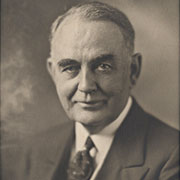
David Ross
Automotive Engineer
David Ross, an inventor with some 88 patents, was a Purdue alumnus who went on to become a trustee and noted university benefactor.
Born in 1870, Ross graduated from Purdue in 1893 with a degree in mechanical engineering. He went back home to the Brookston area upon graduation, but his creation of new devices for the young automobile industry caught the attention of car manufacturers, and he went on to form the Ross Gear and Tool Co.
Ross would return to Purdue, serving first on an alumni committee and later on the university’s Board of Trustees. He played a significant role in raising funds for the Purdue Memorial Union and was instrumental in developing Ross-Ade Stadium, faculty pensions and the Purdue University Airport. He also was behind the creation of the Purdue Research Foundation.
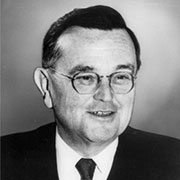
R. Games Slayter
Fiberglass Developer
A one-time tuba player in Purdue University’s “All-American” Marching Band is credited with the development of Fiberglas, the world’s first commercial fiberglass product.
R. Games Slayter, an Indiana native, graduated from Purdue with a bachelor’s degree in chemical engineering in 1921. In the early part of his career, he worked at Owens-Illinois Glass Co. in Toledo, Ohio. It was there that he first created the coarse fibers that led to the production of Fiberglas.
Slayter continued his work in 1938 as vice president of research and development, refining Fiberglas’ production process to make it financially viable. He remained with the company, which merged to become Owens-Corning Fiberglas Corp., amassing more than 90 patents in fiberglass technology before retiring in the 1960s. Slayter even served as a consultant for NASA before the end of his career.
Thanks to a gift from Slayter and his wife, Marie, the Slayter Center of Performing Arts was constructed in 1964.
TechnologY
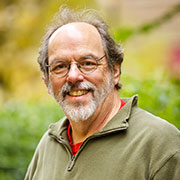
Ward Cunningham
Wiki Pioneer
Alumnus and computer programmer Howard G. “Ward” Cunningham wrote the first Wiki application. A pioneer in both design patterns and Extreme Programming, he started programming the software WikiWikiWeb in 1994.
Cunningham called Wiki “the simplest online database that could possibly work.” Wikis quickly caught on as a means for collaboratively creating, vetting and maintaining online documents, its application made famous by Wikipedia. They helped lay the groundwork for today’s internet. Cunningham received his bachelor’s degree in interdisciplinary engineering (electrical engineering and computer science) and his master’s degree in computer science from Purdue.
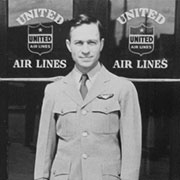
Ralph S. Johnson
Aviation Pioneer
Purdue graduate and pilot Capt. Ralph S. Johnson did more than just fly planes. His innovations helped develop the world of aviation.
Johnson, an Indiana native, is credited with creating the stabilized approach to landing taught to all U.S. Air Force multi-engine pilots as well as producing a movie called “All Weather Flying Methods,” used by training commands. A new method of de-icing planes and a standardized checklist of procedures in the cockpit also can be listed among the pioneer’s accomplishments.
In addition, spraying equipment that he invented was used to adapt warplanes for use in agriculture aerial applications.
Johnson graduated in 1930 with a bachelor’s degree in aeronautical and mechanical engineering. He started as an Army pilot, later moving on to chief pilot flying Ford Tri-Motors for National Air Transport by 1935.
During the early years of World War II, he developed and tested programs geared toward air safety. From 1935-47, he flew hundreds of planes as chief test pilot for United Airlines in Cheyenne, Wyoming. He also served two terms in the Wyoming State Legislature.
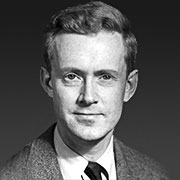
Edward Purcell
Magnetic Engineering Pioneer
Edward Mills Purcell discovered that by using a strong magnetic field and precisely tuned microwaves one can measure nuclear resonance frequency and magnetism.
Purcell, born in Taylorville, Illinois, studied electrical engineering at Purdue, graduating in 1933. He shared the Nobel Prize in physics in 1952 with Felix Bloch for their development of new methods for nuclear magnetic precision measurements and discoveries in connection therewith.
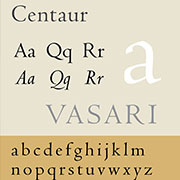
Bruce Rogers
Publishing Pioneer
Typeface designer Bruce Rogers took the publishing world by storm with a stylized creation he dubbed Centaur. The typeface, inspired by Renaissance-period printing, launched in 1914, leading to an acclaimed career for the Lafayette native born in 1874. Over time, he led projects for the world’s most prestigious publishing houses, including 37 volumes of Shakespeare’s classics.
Rogers, an 1890 graduate of Purdue, took his first illustration job with the Indianapolis News. However, his love of travel quickly led him to Massachusetts. Publisher George H. Mifflin offered him a spot with Riverside Press.
In 1912, he left for a freelance career in New York City. His accomplishments as a typographer included work with Cambridge University Press, Harvard University Press and Montague Press. In 1914, his signature Centaur typeface became a publishing standard.
Typeface fame prompted Oxford University Press to seek out his expertise for its Oxford Lectern Bible, published in 1935. The project further propelled Rogers into the limelight. The Library of Congress honored his work by emblazing his printer’s emblem on two bronze doors. Rogers was the first living printer to be honored by the Library of Congress.
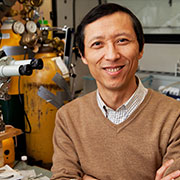
Riyi Shi
Medical Science Pioneer
Riyi Shi, Mari Hulman George Endowed Professor of Applied Neuroscience, is a medical scientist specializing in uncovering the mechanisms of central nervous system trauma and diseases and instituting new treatments through innovative experimentation and pioneering new strategies in the field.
His research contributions include originating the use of double sucrose gap technique for recording action potential conduction, establishing the methods of neuronal membrane resealing by polyethylene glycol (PEG), and identifying acrolein as a key pathological factor in spinal cord injury and multiple sclerosis.
Shi, along with professor Richard Borgens and former professor Andrew Blight, developed the Ampyra drug, the first and only FDA-approved drug to help multiple sclerosis patients improve their ability to walk and other motor skills.
Shi graduated from Shanghai Jiao Tong University and the University of North Texas before earning his PhD from Purdue in developmental neurobiology.
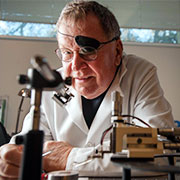
Jerry Woodall
Engineering Pioneer
Jerry Woodall, who was the Epstein Distinguished Professor in what is now Purdue’s Elmore Family School of Electrical and Computer Engineering, is known for his development of compound semiconductor materials and devices, including bright-red LED lights found in brakes and stoplights, for which he received the National Medal of Technology in 2001.
The recipient of 67 U.S. patents and hundred of awards, Woodall researched at Purdue from 1994-98, returning as director of the Burton D. Morgan Center for Entrepreneurship in 2005 and remaining at the university until 2012.
Medicine and Health
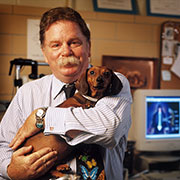
Richard Borgens
Multiple Sclerosis Medicine Developer
Richard Borgens was the Mari Hulman George Professor of Applied Neuroscience in the College of Veterinary Medicine and a professor of biomedical engineering. He was also a founding director of Purdue’s Center for Paralysis Research and a founding board member and chief scientific officer for Andara Life Sciences Inc.
Borgens, in collaboration with Riyi Shi and Andrew Blight (former Purdue professor), developed the drug Ampyra, which has received approval from the U.S. Food and Drug Administration, for improving motor function in patients with multiple sclerosis. Ampyra is the first and only FDA-approved therapy addressing walking impairment in MS patients — one of the most difficult and pervasive challenges of the disease. In clinical trials, patients who took Ampyra demonstrated an increased walking speed, regardless of which of the four major types of MS they exhibited (relapsing remitting, secondary progressive, progressive relapsing or primary progressive). Researchers at Purdue developed the original concept and basic science, and conducted initial animal studies at Purdue’s Center for Paralysis Research facilities. The first clinical testing of the drug in paraplegic canines occurred on the Purdue campus in the College of Veterinary Medicine.
Borgens received his PhD in biophysics and experimental zoology from Purdue in 1977 and was a postdoctoral fellow at Yale University for three years. He earned his bachelor’s and master’s degrees from North Texas State University in 1970 and 1973, respectively. He was a National Paraplegia Foundation Fellow at Yale and worked at Jackson Laboratory and the Institute for Medical Research before joining Purdue’s faculty in 1982.
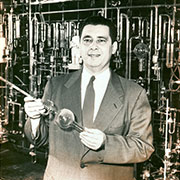
Herbert Brown
Chemistry Pioneer
Herbert C. Brown was one of the leading American chemists of the 20th century. His Nobel Prize-winning work with boron compounds revolutionized synthetic organic chemistry.
His discoveries at Purdue opened entirely new avenues in both academic and industrial chemistry. Boranes are now used in the synthesis of many organic compounds, including medications such as the antidepressant Prozac and the cholesterol-lowering drug Lipitor. Brown came to Purdue in 1947. During the late 1950s, he and his students discovered that unsaturated organic molecules can be readily converted to organoboranes through hydroboration reactions, in which boron and hydrogen add to multiple bonds.
He supervised a very large group of graduate students and postdoctoral researchers — most notably Ei-ichi Negishi and Akira Suzuki, 2010 Nobel laureates who studied with Brown in the 1960s. Brown retired in 1979 but continued to be an active researcher.
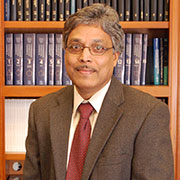
Arun Ghosh
HIV Medicine Developer
Arun K. Ghosh is the Ian P. Rothwell Distinguished Professor of Chemistry and Medicinal Chemistry and Molecular Pharmacology at Purdue. He created a molecule that was developed into the first FDA-approved treatment for drug-resistant HIV.
Ghosh was born in Calcutta, India. He obtained his BS degree in chemistry in 1979 from Calcutta University and his MS degree in chemistry in 1981 from the Indian Institute of Technology in Kanpur. He received his PhD in organic chemistry in 1985 from the University of Pittsburgh.
He was a postdoctoral fellow at Harvard University from 1985-88 and then joined Merck Research Laboratories at West Point, Pennsylvania, as a medicinal chemist. In 1994, he became an assistant professor at the University of Illinois, Chicago. He joined the Purdue faculty in 2005.
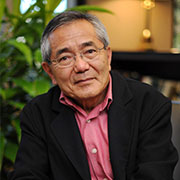
Ei-ichi Negishi
Pharmaceutical Industry Pioneer
Professor Ei-ichi Negishi was awarded the 2010 Nobel Prize in chemistry for developing palladium-catalyzed cross-coupling to link carbon atoms and synthesize molecules. In addition to its use in the development of the painkiller naproxen and the cancer treatment Taxol, it is estimated that “Negishi coupling” is used in more than one-quarter of all chemical reactions in the pharmaceutical industry. The technique also has been used in fluorescent marking essential for DNA sequencing and in the creation of materials for thin LED displays.
Born in 1935, Negishi came to the United States in 1960 after graduating from the University of Tokyo.
In 1962, while studying for his doctorate at the University of Pennsylvania, he met Purdue chemistry professor Herbert C. Brown — a pioneer in synthetic organic chemistry. With Brown as a mentor, Negishi arrived in West Lafayette as a postdoctoral researcher in 1966. He then moved to Syracuse University, where he served as an assistant professor (1972-76) and associate professor (1976-79).
Negishi joined the faculty at Purdue in 1979 — the same year Brown was awarded the Nobel Prize in Chemistry.
In 1999, he was named the Inaugural Herbert C. Brown Distinguished Professor in chemistry.
Food and Consumer
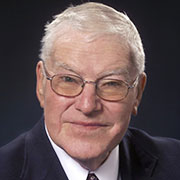
Robert C. Baker
Chicken Nugget Innovator
Robert C. Baker, who grew up in Newark, New Jersey, earned his PhD from Purdue. He became a Cornell University poultry science and food science professor after graduating from Purdue, and helped develop chicken nuggets, turkey ham and poultry hot dogs.
In 1963, Baker developed a way to keep breading attached to the nuggets during frying and enable people to eat the chicken without the breading falling off. This resulted in the popular nuggets that today are a staple in grocery stores and fast-food restaurants.
Baker founded Cornell’s Institute of Food Science and Marketing in 1970. He also created Cornell chicken barbecue sauce, a popular sauce in the state of New York. He annually ran a chicken barbecue stand at the New York State Fair. Cornell University said President Clinton and his family asked for the sauce during their visit in 1999.
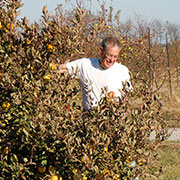
Jules Janick
Apple Pioneer
GoldRush. Pixie Crunch. CrimsonCrisp. Horticulturist Jules Janick not only created new apple varieties, he also named his creations. The push for new varieties started as a pursuit to end apple scab.
Disease-resistant breeds meant more productivity for farmers. Appealing names won over grocery consumers, their creative flair suggesting flavor profiles. Janick enjoyed the process, even giving a nod to “Star Trek” with a red apple variety he dubbed The Enterprise.
Janick earned a Purdue master’s and doctorate before becoming a professor in the College of Agriculture. He was named the James Troop Distinguished Professor of Horticulture and oversaw the success of six utility patents and 23 plant patents.
During his 69 years of service to Purdue, he edited groundbreaking horticulture publications, authoring over 150 volumes. He also founded Horticultural Reviews and Plant Breeding Reviews. His accomplishments landed him a spot in the American Society for Horticultural Science Hall of Fame.
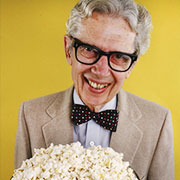
Orville Redenbacher
Popcorn Pioneer
Orville Redenbacher’s desire for excellence took him to the point where his name is a common household term in the United States. He was raised on a small farm near Brazil, Indiana. He was a member of many state champion 4-H judging teams. He received an appointment to West Point but chose instead to attend the Purdue College of Agriculture, where he was active in the Alpha Gamma Rho fraternity and an editor of the Debris, the Agriculturalist and the Purdue Exponent.
Redenbacher graduated in 1928 and became a vocational agriculture teacher for one year before joining the Indiana Cooperative Extension as an assistant agent in Terre Haute. Soon, he was appointed county agricultural agent and served until 1939.
He left Extension to organize Princeton Farms, then the largest farm in Indiana. He instigated many innovative programs in purebred livestock production, hybrid seed corn, and certified seed and began production of Princeton Farms popcorn. While there, he assumed positions of leadership in state programs in all the areas of agricultural production in which he was involved.
In 1952, Redenbacher and Charles Bowman organized Chester Hybrids at Valparaiso. They rapidly became a leading regional producer of hybrid corn, small grain seeds, and popcorn seed and sold agricultural equipment and supplies as well. They also packaged popping corn, but it was not until 1970 that they entered the gourmet popcorn business with Marshall Field & Co. in Chicago as their first customer.
Redenbacher died in 1995. The city of Brazil still celebrates Redenbacher’s life and accomplishments with its annual Popcorn Festival.
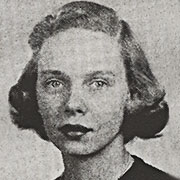
Ruth Siems
Stove Top Stuffing Creator
Purdue graduate Ruth Siems took a simple recipe and fed America. The home economist — and mastermind behind Stove Top stuffing — launched her career at General Foods as a product researcher.
Born in 1931, Siems, a 1953 home economics graduate, made strides with cake mixes and flours at the General Foods facility in her hometown of Evansville.
After a midcareer transfer to the East Coast, Siems landed on the stuffing idea as America clamored for more options in the convenience food lineup. Launching in 1971, Stove Top was deemed savory enough for Thanksgiving, yet a foolproof go-to for weeknight meals. The secret? Siems’ patent for precise bread crumb dimensions. The processing technique allowed for quick rehydration — essential for thorough stove-top preparation.
She worked at General Foods for nearly 35 years. Kraft Foods owns the brand today and sells 60 million boxes annually.
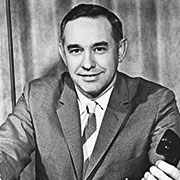
Frank Thomas Jr.
Ice Cream Innovator
Frank Thomas Jr. graduated from Purdue with a degree in mechanical engineering. He is credited with creating the first patented soft serve ice cream machine, founding the General Equipment Co. in 1929 to distribute his creations. He also helped develop a grill that would flame-broil beef patties.
Thomas founded the successful Burger Chef fast-food chain in Indianapolis in 1954. At its peak, there were more than 1,000 stores. Thomas sold the business to General Foods in 1968, and Hardee’s would later acquire the chain.
